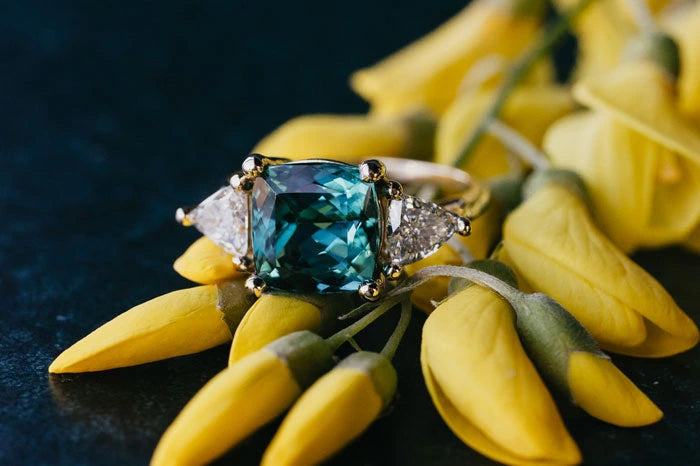When it comes to purchasing a diamond, one of the most important things to consider is the Diamond 4Cs. These four characteristics—Cut, Color, Clarity, and Carat weight—are crucial in determining the quality, value, and appearance of the diamond. Whether you’re buying a diamond ring for a special occasion or simply learning more about gemstones, understanding the Diamond 4Cs will help you make an informed and confident decision. This article will break down each of the 4Cs and explain why they are essential in choosing the perfect diamond.
The Importance of the Diamond Cut
The diamond cut is perhaps the most significant factor in the overall beauty and brilliance of a diamond. Unlike other Cs, the cut refers to how well the diamond has been shaped and faceted. A well-cut diamond will reflect light brilliantly, giving it a stunning sparkle. When evaluating the Diamond 4Cs, it’s crucial to focus on the cut because it has a direct impact on the gemstone’s visual appeal.
A diamond with a poor cut will appear dull and lifeless, regardless of its other attributes. On the other hand, an excellent cut enhances the diamond’s natural sparkle. The cut is graded based on factors such as symmetry, proportion, and the quality of its facets. While the other Diamond 4Cs play a role, the cut is the one that truly elevates the overall look of the diamond.
Understanding Diamond Color
Color is the second factor in the Diamond 4Cs that every buyer should understand. In diamonds, the color scale ranges from D (colorless) to Z (light yellow or brown). The more colorless the diamond, the more valuable it is. Diamonds that fall in the D-F range are considered colorless, and they are prized for their pure, transparent appearance.
While many people might assume that all diamonds are clear, the subtle hues of yellow or brown can have a noticeable impact on the overall value. When examining color, it’s important to consider how it will appear once set in jewelry. The Diamond 4Cs grading system ensures that buyers can find a diamond that suits their preferences and budget without compromising on quality.
Diamond Clarity and Its Impact on Value
Another essential aspect of the Diamond 4Cs is clarity. Clarity refers to the presence of internal or external imperfections, known as inclusions and blemishes. A diamond that is free from any flaws is considered flawless, but these diamonds are extremely rare and expensive. Most lab grown diamonds will have some level of inclusions or blemishes, but they are often microscopic and difficult to see without magnification.
The clarity grade of a diamond can significantly affect its price. The higher the clarity, the more valuable the diamond. However, it’s important to keep in mind that most inclusions are not visible to the naked eye, and their impact on the overall beauty of the stone may be minimal. Understanding the Diamond 4Cs allows you to balance clarity with the other factors to choose a diamond that meets your standards.
Carat Weight: What It Means for Your Diamond
The carat weight of a diamond refers to its size. One carat equals 200 milligrams, but the carat weight does not necessarily indicate the diamond’s overall size, as the cut can influence how large the diamond appears. Carat weight is a crucial element of the Diamond 4Cs because it directly impacts the price. Generally, the larger the diamond, the more expensive it is, though this is also affected by the quality of the cut, color, and clarity.
While carat weight is an important consideration, it’s essential to remember that bigger isn’t always better. A smaller diamond with an excellent cut, high clarity, and superior color can often be more visually appealing than a larger stone with lower quality in the other Diamond 4Cs.
How the 4Cs Influence Diamond Prices
The Diamond 4Cs work together to determine the overall price of a diamond. A diamond with an excellent cut, high clarity, colorless quality, and larger carat weight will undoubtedly be more expensive than one with lower grades in these categories. However, this doesn’t mean that you need to settle for a lower quality diamond to fit your budget.
By understanding the Diamond 4Cs, you can prioritize the factors that matter most to you. For instance, if brilliance is a top priority, you might be willing to choose a diamond with slightly lower clarity in exchange for a better cut. On the other hand, if you’re looking for a larger diamond, you might opt for one with a higher carat weight but with a lower color grade.
Looking for the perfect diamond jewelry? NoviTadiamonds.com offers a stunning collection of high-quality, certified diamonds for every occasion. Whether it’s for a gift or a treat for yourself, we’ve got something special for you!
Conclusion: Choose Wisely with the Diamond 4Cs
When shopping for a diamond, understanding the Diamond 4Cs is essential to making an informed purchase. Each of these four factors—cut, color, clarity, and carat weight—affects the appearance and value of the diamond. While it’s tempting to focus solely on carat weight or price, remember that the cut can be the most influential factor in the diamond’s beauty. Similarly, color and clarity contribute to its overall appeal.







